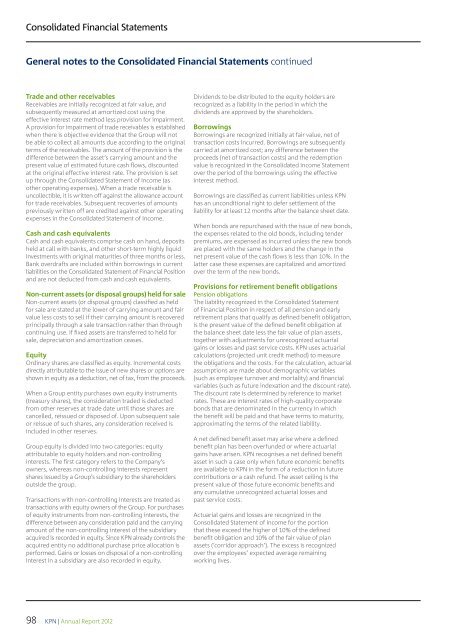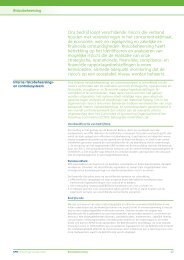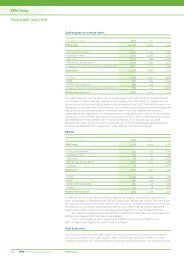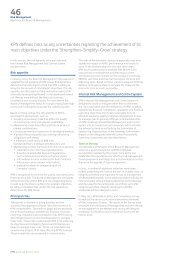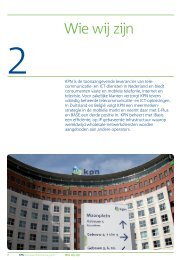FINANCIAL STATEMENTS - KPN
FINANCIAL STATEMENTS - KPN
FINANCIAL STATEMENTS - KPN
You also want an ePaper? Increase the reach of your titles
YUMPU automatically turns print PDFs into web optimized ePapers that Google loves.
Consolidated Financial Statements<br />
General notes to the Consolidated Financial Statements continued<br />
Trade and other receivables<br />
Receivables are initially recognized at fair value, and<br />
subsequently measured at amortized cost using the<br />
effective interest rate method less provision for impairment.<br />
A provision for impairment of trade receivables is established<br />
when there is objective evidence that the Group will not<br />
be able to collect all amounts due according to the original<br />
terms of the receivables. The amount of the provision is the<br />
difference between the asset’s carrying amount and the<br />
present value of estimated future cash flows, discounted<br />
at the original effective interest rate. The provision is set<br />
up through the Consolidated Statement of Income (as<br />
other operating expenses). When a trade receivable is<br />
uncollectible, it is written off against the allowance account<br />
for trade receivables. Subsequent recoveries of amounts<br />
previously written off are credited against other operating<br />
expenses in the Consolidated Statement of Income.<br />
Cash and cash equivalents<br />
Cash and cash equivalents comprise cash on hand, deposits<br />
held at call with banks, and other short-term highly liquid<br />
investments with original maturities of three months or less.<br />
Bank overdrafts are included within borrowings in current<br />
liabilities on the Consolidated Statement of Financial Position<br />
and are not deducted from cash and cash equivalents.<br />
Non-current assets (or disposal groups) held for sale<br />
Non-current assets (or disposal groups) classified as held<br />
for sale are stated at the lower of carrying amount and fair<br />
value less costs to sell if their carrying amount is recovered<br />
principally through a sale transaction rather than through<br />
continuing use. If fixed assets are transferred to held for<br />
sale, depreciation and amortization ceases.<br />
Equity<br />
Ordinary shares are classified as equity. Incremental costs<br />
directly attributable to the issue of new shares or options are<br />
shown in equity as a deduction, net of tax, from the proceeds.<br />
When a Group entity purchases own equity instruments<br />
(treasury shares), the consideration traded is deducted<br />
from other reserves at trade date until those shares are<br />
cancelled, reissued or disposed of. Upon subsequent sale<br />
or reissue of such shares, any consideration received is<br />
included in other reserves.<br />
Group equity is divided into two categories: equity<br />
attributable to equity holders and non-controlling<br />
interests. The first category refers to the Company’s<br />
owners, whereas non-controlling interests represent<br />
shares issued by a Group’s subsidiary to the shareholders<br />
outside the group.<br />
Transactions with non-controlling interests are treated as<br />
transactions with equity owners of the Group. For purchases<br />
of equity instruments from non-controlling interests, the<br />
difference between any consideration paid and the carrying<br />
amount of the non-controlling interest of the subsidiary<br />
acquired is recorded in equity. Since <strong>KPN</strong> already controls the<br />
acquired entity no additional purchase price allocation is<br />
performed. Gains or losses on disposal of a non-controlling<br />
interest in a subsidiary are also recorded in equity.<br />
Dividends to be distributed to the equity holders are<br />
recognized as a liability in the period in which the<br />
dividends are approved by the shareholders.<br />
Borrowings<br />
Borrowings are recognized initially at fair value, net of<br />
transaction costs incurred. Borrowings are subsequently<br />
carried at amortized cost; any difference between the<br />
proceeds (net of transaction costs) and the redemption<br />
value is recognized in the Consolidated Income Statement<br />
over the period of the borrowings using the effective<br />
interest method.<br />
Borrowings are classified as current liabilities unless <strong>KPN</strong><br />
has an unconditional right to defer settlement of the<br />
liability for at least 12 months after the balance sheet date.<br />
When bonds are repurchased with the issue of new bonds,<br />
the expenses related to the old bonds, including tender<br />
premiums, are expensed as incurred unless the new bonds<br />
are placed with the same holders and the change in the<br />
net present value of the cash flows is less than 10%. In the<br />
latter case these expenses are capitalized and amortized<br />
over the term of the new bonds.<br />
Provisions for retirement benefit obligations<br />
Pension obligations<br />
The liability recognized in the Consolidated Statement<br />
of Financial Position in respect of all pension and early<br />
retirement plans that qualify as defined benefit obligation,<br />
is the present value of the defined benefit obligation at<br />
the balance sheet date less the fair value of plan assets,<br />
together with adjustments for unrecognized actuarial<br />
gains or losses and past service costs. <strong>KPN</strong> uses actuarial<br />
calculations (projected unit credit method) to measure<br />
the obligations and the costs. For the calculation, actuarial<br />
assumptions are made about demographic variables<br />
(such as employee turnover and mortality) and financial<br />
variables (such as future indexation and the discount rate).<br />
The discount rate is determined by reference to market<br />
rates. These are interest rates of high-quality corporate<br />
bonds that are denominated in the currency in which<br />
the benefit will be paid and that have terms to maturity,<br />
approximating the terms of the related liability.<br />
A net defined benefit asset may arise where a defined<br />
benefit plan has been overfunded or where actuarial<br />
gains have arisen. <strong>KPN</strong> recognises a net defined benefit<br />
asset in such a case only when future economic benefits<br />
are available to <strong>KPN</strong> in the form of a reduction in future<br />
contributions or a cash refund. The asset ceiling is the<br />
present value of those future economic benefits and<br />
any cumulative unrecognized actuarial losses and<br />
past service costs.<br />
Actuarial gains and losses are recognized in the<br />
Consolidated Statement of Income for the portion<br />
that these exceed the higher of 10% of the defined<br />
benefit obligation and 10% of the fair value of plan<br />
assets (‘corridor approach’). The excess is recognized<br />
over the employees’ expected average remaining<br />
working lives.<br />
98<br />
<strong>KPN</strong> | Annual Report 2012


